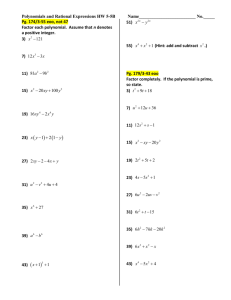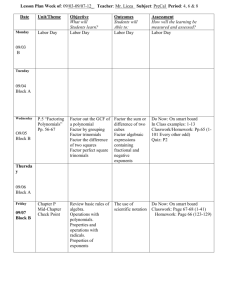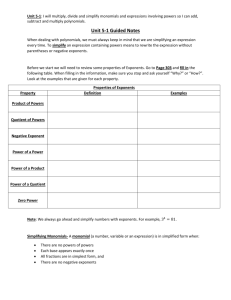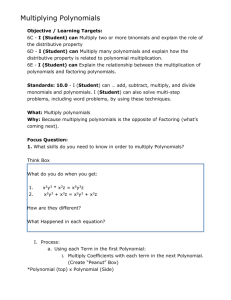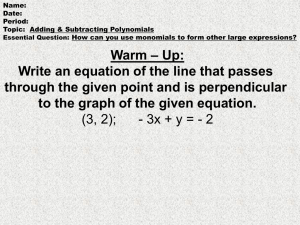Polynomial notes and practice
advertisement
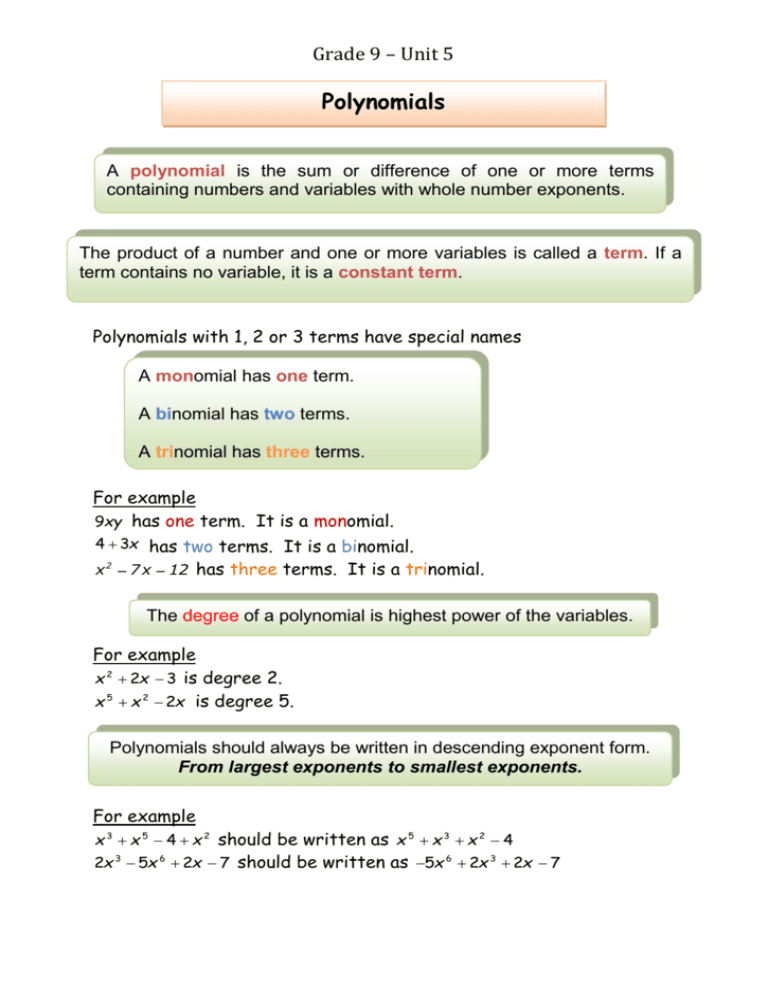
Grade 9 – Unit 5 Polynomials A polynomial is the sum or difference of one or more terms containing numbers and variables with whole number exponents. The product of a number and one or more variables is called a term. If a term contains no variable, it is a constant term. Polynomials with 1, 2 or 3 terms have special names A monomial has one term. A binomial has two terms. A trinomial has three terms. For example 9xy has one term. It is a monomial. 4 3x has two terms. It is a binomial. x 2 7 x 12 has three terms. It is a trinomial. The degree of a polynomial is highest power of the variables. For example x 2 2x 3 is degree 2. x 5 x 2 2x is degree 5. Polynomials should always be written in descending exponent form. From largest exponents to smallest exponents. For example x 3 x 5 4 x 2 should be written as x 5 x 3 x 2 4 2x 3 5x 6 2x 7 should be written as 5x 6 2x 3 2x 7 Addition and Subtraction of Polynomials When adding or subtracting polynomials we combine only the like terms. If the terms contain exactly the same variables and exponents, they are called like terms. For Example 2x and 7x are like terms x and y are not like terms x 2 and 3x 2 are like terms. x 2 and x are not like terms 5xy 2z and 2zxy 2 are like terms 3xy 2 and 2x 2 y are unlike terms Examples 4p 7q 5q 3p 7d 2 7d 3d 4p 3p 7q 5q 7d 2 7 3 d 4 3 p 7 5 q 7d 2 10d p 12q If there are brackets we need to remove them before adding or subtracting. When removing a bracket following a negative remember to change the signs in the brackets. xy 2 2x 3 2 4x 2xy 2 2x 2 4 x 2 3x 3 xy 2 2x 3 2 4x 2xy 2 2x 2 4 x 2 3x 3 xy 2 2xy 2 2x 4x 3 2 2x 2 x 2 3x 4 3 3xy 2 2x 5 x 2 3x 1 2 Practice 1. Simplify: (a) 9k k (c) (b) 10d 6d (d) 16r 12r 3p 12p (e) 10r 10r 2. (f) 14k 14k Simplify (a) 4a2 3a 5a2 (c) 4x 2y 8xy 2 2x 2y (b) 6g f 7f 18g 3f (d) 9 4w 15 6w 6 2w (e) 8k 6w 14 8w k 3w 9k 10 3 3. Simplify: (a) p 8 p 8 (b) 4x 5 9x 14 (c) 4km (d) 4x 8y x 10y (e) 4ab 5ab 2a b ab 5ab 7 a b (f) 2c cd 5d 6c 2cd 4d 2 3m2 6 2km2 15 2 2 2 4 2 Multiplying Polynomials To multiply monomials the numerical coefficients (numbers) are multiplied and the variables are multiplied using the exponent rule for multiplication. Exponent rule: For any numbers x, m and n x m x n x mn For example (x 3 )(x 2 ) x) (x) (x x) (x x 5 2mn 3mn 2 3 m m n n 6 m1 1n11 6m2n2 (4x 2y 2 )(3xy 5 ) 4 3 x 2 x y 2 y 5 12x 2 1y 2 5 12x 3 y 7 To multiply a monomial with a polynomial the distributive property is used. Distributive Property: To multiply a factor by a sum of numbers, multiply the factor by each number in the sum. Then add the products. a b c a b a c For example a) 3x 2 x 4 3x 2 x 3 x 2 4 3x 3 12x 2 b) y 2 3y 4 2y y 2 2y 3y 2y 4 2y 2y 3 6y 2 8y 5 Practice Simplify each of the following: 1. 2x 3y 2. 4x 4x 3. 3xy 2xy 4. 6pq p3q 2 5. 8ab 8abc 6. 6xy 3 6 7. 2m n 8. (5a 2b3 )2 9. (5 y 2 )(4 xy 3 ) 2 3 10. (2 p)(3 p 2 q)(6 pq 2 ) 11. 3xy 2x 2y 2 12. 3 a b 13. 1 xy 6 3p p 3 7 14. 2m2 3m3 2m2 15. 4 3 2z z 2 16. 3 p2 2p 4 17. 4w 2w 4 w 2 18. 2r 2q r 2 q 2 1 19. (2a)(a2 2a 1) 20. (3pq)(p2 2pq q2 ) 8 To multiply two binomials the distributive property is used twice. This can also be called the FOIL method. For example x 4 x 1 x x 1 4 x 1 x 2 x 4x 4 x2 5 x 4 3p 1 2p 4 3 p 2p 4 1 2p 4 6 p2 12p 2p 4 6p2 10 p 4 2x 3 x 4 2x 2 8x 3x 12 2x 2 11x 12 2y 3x 2 2y 3x 2y 3x 4y 2 6yx 6xy 9x 2 4y 2 6xy 6xy 9x 2 4y 2 12xy 9x 2 To multiply a binomial by a polynomial the first term of the binomial is multiplied by each term in the polynomial and the result is then added to the product of the second term of the binomial with each term of the polynomial. The result must then be simplified if possible. x 2 x 2 3x 2 4x 2y xy x y x 3x 2x 2x 6x 4 4x 2y 4x 2 4xy 2xy 2 2xy 2y 2 x 3 x 2 8x 4 4x 2y 2xy 2 4x 2 2y 2 6xy 3 2 2 Each term is one bracket must be multiplied with each term in the second bracket. 9 Multiply each of the following. 1. x 3 3x 5 2. 2s 4 3s 7 3. 2s 4 3s 7 4. 3w 3 w 3 5. y 4 y 4 6. 7. 9. (3x 2)(x 5) (2y 7)(2y 7) 8. 10. 10 (3m 2)(2m 4) (8p 2)(8p 2) (4x 3)2 Multiply each of the following. 11. 3ab 2b ab 4b 13. 4x 15. y 4 y 2 4y 3 17. 19. 2 3y 2 2x 2 y2 12. 9 4w 14. 16. (3x 1)(5 2x x2 ) 18. (2y 7)(2y 2 7y 1) (5x 4)(5x 4) (m 2) m2 3m 1 4r 2t r 2 2rt t 2 20. 11 2 (4x2 1) 2x 3y 1 Dividing Polynomials To divide a polynomial by a monomial each term of the polynomial is divided by the monomial. The numerical coefficients are divided and the variables are dividing using the exponent rule for division. Division property of exponents For every nonzero number a and exponents m and n , am am n an For example 16m2n 16 m2 n 4m 4mn 4 m n 14p3q2 14 p3 q2 2p2q 7 pq 7 p q 12a3 b2 6ab3 18a2b 12a3 b2 6ab3 18a2b 3ab 3ab 3ab 3ab 2 2 4a b 2b 6a 50mn2 25m2 n 50mn2 25m2n 5mn 5mn 5 mn 10n 5m 10n 5m 12 Practice 1. 33x 2 11x 11 11 2. 14n2 7n 28nx 7n 3. 3cd 42cd 2 3cd 4. 8x 2y 24x 2y 2 8xy 2 8xy 5. 8mn 4mn2 4n2 4n 7. 63k 9. 2 6. 7k 21kn 7k 2x 2 y x2 x2 2 2 8. (45xy 72xy 35xy) (9xy) (15p2q2r 2 20pqr ) ( pqr ) 10. 13 (12abc 6ac 18bc) (6) Simplifying Polynomials To simplify polynomials that have more than 1 operation remember to follow the order of operations. Brackets Exponents Division or Multiplication (from left to right) Addition or Subtraction (from left to right) Simplify each of the following 1. 2 3y 5 12 2. 7 c 4 2 c 18 3. 14p 2 r 7 p 6r 4. y 6y 8 5 y 2 2y 1 14 5. 4a 1 3a 2 a 2 a 2 6. c 4 7. 8. 4s p s p 2s p 2s 9. 2x 1 2x 1 2x 3 2 5y 2y 4 y 2 4y 7 7 10. 15 2 2c 1 c 5 6r 4m 5r 3m 8r 11mr 3r 11. a (12a2b2 4ab 1) a 13. 2(y 3)2 3(y 1)2 12. (m n)2 (m n)2 mn 14. 7a(a2 b2 ) 2ab 2b(a2 b2 ) 16



